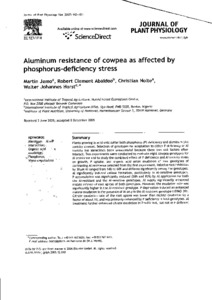| dc.contributor.author | Jemo, M. |
| dc.contributor.author | Abaidoo, R.C. |
| dc.contributor.author | Nolte, C. |
| dc.contributor.author | Horst, Walter J. |
| dc.date.accessioned | 2019-12-04T11:18:17Z |
| dc.date.available | 2019-12-04T11:18:17Z |
| dc.date.issued | 2007 |
| dc.identifier.citation | Jemo, M., Abaidoo, R.C., Nolte, C. & Horst, W.J. (2007). Aluminum resistance of cowpea as affected by phosphorus-deficiency stress. Journal of Plant Physiology, 164(4), 442-451. |
| dc.identifier.issn | 0176-1617 |
| dc.identifier.uri | https://hdl.handle.net/20.500.12478/3142 |
| dc.description.abstract | Plants growing in acid soils suffer both phosphorus (P) deficiency and aluminum (Al) toxicity stresses. Selection of genotypes for adaptation to either P deficiency or Al toxicity has sometimes been unsuccessful because these two soil factors often interact. Two experiments were conducted to evaluate eight cowpea genotypes for Al resistance and to study the combined effect of P deficiency and Al toxicity stress on growth, P uptake, and organic acid anion exudation of two genotypes of contrasting Al resistance selected from the first experiment. Relative root inhibition by 30 microM Al ranged from 14% to 60% and differed significantly among the genotypes. Al significantly induced callose formation, particularly in Al-sensitive genotypes. P accumulation was significantly reduced (28% and 95%) by Al application for both the Al-resistant and the Al-sensitive genotypes. Al supply significantly enhanced malate release of root apices of both genotypes. However, the exudation rate was significantly higher in the Al-resistant genotype. P deprivation induced an enhanced malate exudation in the presence of Al only in the Al-resistant genotype IT89KD-391. Citrate exudation rate of the root apices was lower than malate exudation by a factor of about 10, and was primarily enhanced by P deficiency in both genotypes. Al treatment further enhanced citrate exudation in P-sufficient, but not in P-deficient plants. The level of citrate exudation was consistently higher in the Al-resistant genotype IT89KD-391 particularly in presence of Al. It is concluded that the Al-resistant genotype is better adapted to acid Al-toxic and P-deficient soils than the Al-sensitive genotype since both malate and citrate exudation were more enhanced by combined Al and P-deficiency stresses. |
| dc.language.iso | en |
| dc.subject | Aluminum – Al×P Interaction |
| dc.subject | Organic Acid Exudation |
| dc.subject | Phosphorus |
| dc.subject | Vigna Unguiculata |
| dc.title | Aluminum resistance of cowpea as affected by phosphorusdeficiency stress |
| dc.type | Journal Article |
| dc.description.version | Peer Review |
| cg.contributor.affiliation | International Institute of Tropical Agriculture |
| cg.contributor.affiliation | Universität Hannover |
| cg.coverage.region | Africa |
| cg.coverage.region | West Africa |
| cg.coverage.country | Nigeria |
| cg.isijournal | ISI Journal |
| cg.authorship.types | CGIAR and advanced research institute |
| cg.iitasubject | Cowpea |
| cg.iitasubject | Genetic Improvement |
| cg.iitasubject | Nutrition |
| cg.iitasubject | Plant Health |
| cg.accessibilitystatus | Limited Access |
| local.dspaceid | 94608 |
| cg.identifier.doi | http://dx.doi.org/10.1016/j.jplph.2005.12.010 |

